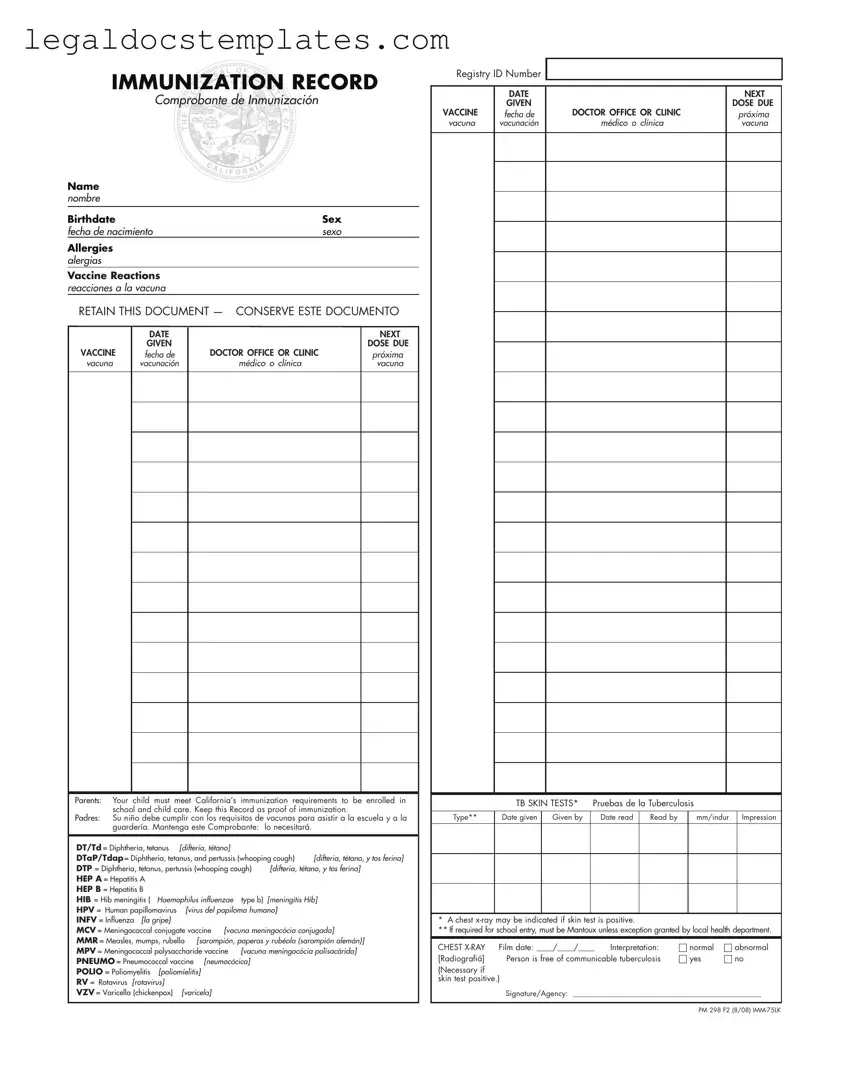An Immunization Record form is a document that keeps track of all the vaccinations an individual has received. It includes important information such as the name, birthdate, sex of the individual, allergies, vaccine reactions, and details of vaccinations including the dates given, the next doses due, vaccines received, and the doctor or clinic where the vaccination was administered. It is an essential record that demonstrates compliance with immunization requirements, especially for children to be enrolled in school and childcare facilities.
Retaining the Immunization Record is crucial for several reasons. Firstly, it serves as proof of vaccination against various contagious diseases, complying with health regulations for school and child care enrollment in California. Furthermore, it helps healthcare providers manage and recommend future vaccinations based on the vaccination history. It is also vital for personal healthcare records, travel requirements, and in situations where evidence of immunization is required.
-
DT/Td: Diphtheria, tetanus
-
DTaP/Tdap: Diphtheria, tetanus, and pertussis (whooping cough)
-
DTP: Diphtheria, tetanus, pertussis (whooping cough)
-
HEP A: Hepatitis A
-
HEP B: Hepatitis B
-
HIB: Hib meningitis (Haemophilus influenzae type b)
-
HPV: Human papillomavirus
-
INFV: Influenza (the flu)
-
MCV: Meningococcal conjugate vaccine
-
MMR: Measles, mumps, rubella
-
MPV: Meningococcal polysaccharide vaccine
-
PNEUMO: Pneumococcal vaccine
-
POLIO: Poliomyelitis
-
RV: Rotavirus
-
VZV: Varicella (chickenpox)
This list ensures a comprehensive coverage against a range of communicable diseases.
The TB skin test is documented in a dedicated section which records the type of test, date given, by whom it was administered, date read, results in millimeters of induration, and the overall impression. If the skin test result is positive, a chest x-ray may be indicated. The form also provides space for noting down the film date and interpretation of the chest x-ray, to confirm the person is free of communicable tuberculosis. This documentation is particularly important if it is required for school entry.
If a vaccine reaction is noted on the Immunization Record, it is important to consult a healthcare provider for advice. They can assess the severity of the reaction, provide treatment if necessary, and advise on the appropriateness of future vaccinations. Keeping healthcare professionals informed of any reactions is crucial for the safety and well-being of the individual.
Yes, in California, presenting an Immunization Record form is a prerequisite for enrolling children in school and child care facilities. This document serves as official proof that the child has received the required vaccinations to protect against various diseases, as mandated by the state's public health requirements.
The "Registry ID Number" refers to a unique identification number assigned to the individual's immunization records in a registry. This can facilitate easy access to the individual’s vaccination history by healthcare providers and schools, ensuring quick verification of immunization status and compliance with health regulations.
Allergies should be clearly documented in the specified section of the Immunization Record form, including any known allergies to medications or vaccine components. This information is crucial for healthcare providers to ensure the safety and well-being of the individual during future vaccinations or medical treatments.
The "date next dose due" is a critical piece of information indicating when the next vaccination dose is scheduled. It aids in ensuring that vaccinations are administered on time, in accordance with the recommended immunization schedule, to maintain optimal protection against infectious diseases.
Yes, the Immunization Record form can be used to document adult vaccinations as well. While the primary emphasis may be on children's immunization for school and child care enrollment, maintaining an up-to-date record of vaccinations is equally important for adults, especially for travel, employment in certain industries, and for personal health management.

